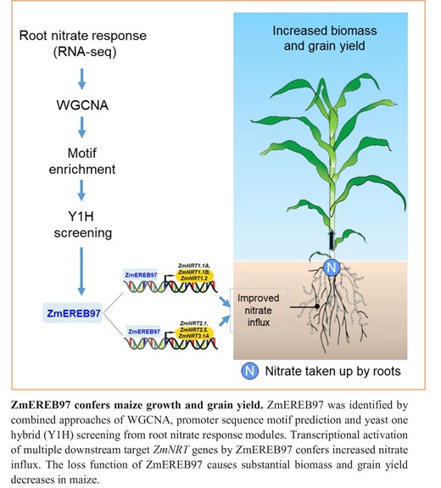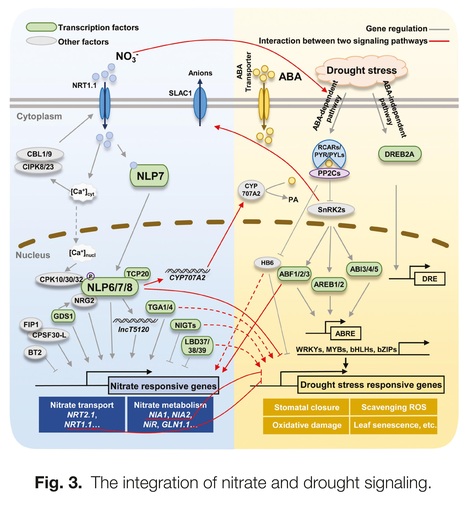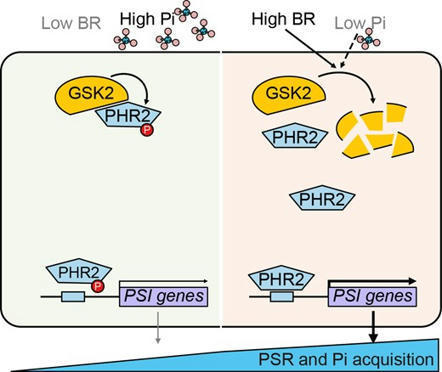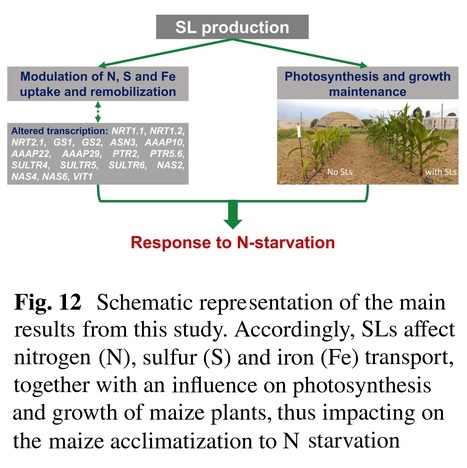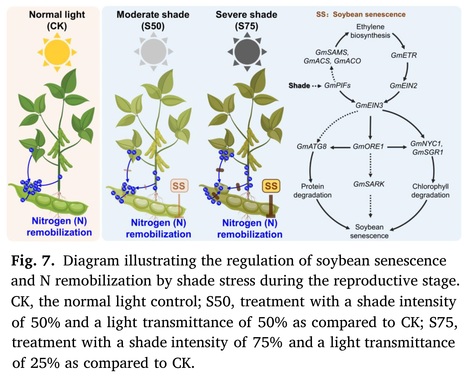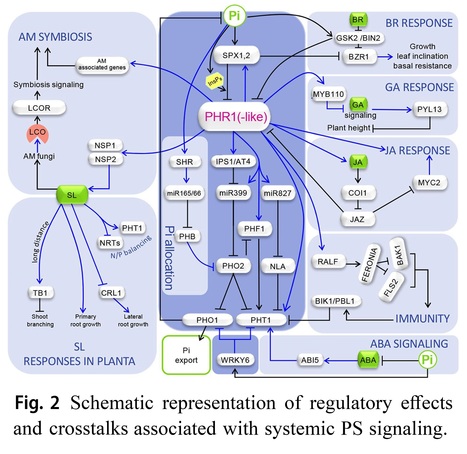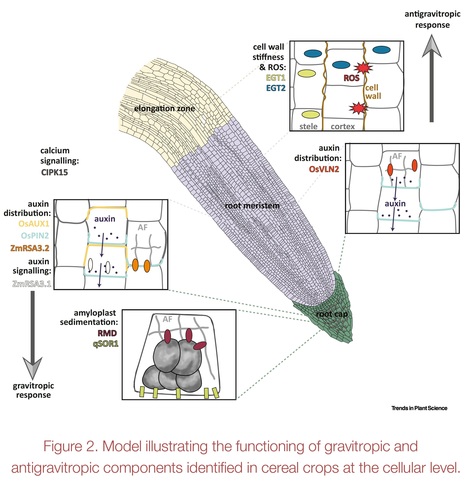 Your new post is loading...
 Your new post is loading...
Authors: s Qi Wu, Jinyan Xu, Yingdi Zhao, Yuancong Wang, Ling Zhou, Lihua Ning, Sergey Shabala and Han Zhao.
Plant Physiology (2024)
One-sentence summary: An ethylene response transcription factor plays an important role in the nitrogen-signaling network and in optimizing nitrate uptake in maize.
Abstract: "Maize (Zea mays L.) has very strong requirements for nitrogen. However, the molecular mechanisms underlying the regulations of nitrogen uptake and translocation in this species are not fully understood. Here, we report that an APETALA2/ETHYLENE RESPONSE FACTOR (AP2/ERF) transcription factor ZmEREB97 functions as an important regulator in the N-signaling network in maize. Predominantly expressed and accumulated in main root and lateral root primordia, ZmEREB97 rapidly responded to nitrate treatment. By overlapping the analyses of differentially expressed genes and conducting a DAP-seq assay, we identified 1446 potential target genes of ZmEREB97. Among these, 764 genes were co-regulated in two lines of zmereb97 mutants. Loss of function of ZmEREB97 substantially weakened plant growth under both hydroponic and soil conditions. Physiological characterization of zmereb97 mutant plants demonstrated that reduced biomass and grain yield were both associated with reduced nitrate influx, decreased nitrate content and less N accumulation. We further demonstrated that ZmEREB97 directly targets and regulates the expression of six ZmNRT genes by binding to the GCC box-related sequences in gene promoters. Collectively, these data suggest that ZmEREB97 is a major positive regulator of the nitrate response and that it plays an important role in optimizing nitrate uptake, offering a target for improvement of nitrogen use efficiency in crops."
Authors: Tomás Urzúa Lehuedé, Victoria Berdion Gabarain, Tomas Moyano, Lucia Ferrero, Miguel Angel Ibeas, Hernan Salinas-Grenet, Gerardo Núñez-Lillo, Romina Acha, Jorge Perez, Florencia Perotti, Virginia Natali Miguel, Fiorella Paola Spies, Miguel A. Rosas, Michitaro Shibata, Diana R. Rodríguez-García, Adrian A. Moreno, Keiko Sugimoto, Karen Sanguinet, Claudio Meneses, Raquel L. Chan, Federico Ariel, Jose M. Alvarez and José M. Estevez.
bioRxiv (2024)
Abstract: "The root hair (RH) cells can elongate to several hundred times their initial size, and are an ideal model system for investigating cell size control. Their development is influenced by both endogenous and external signals, which are combined to form a integrative response. Surprisingly, a low temperature condition of 10°C causes an increased RH growth in Arabidopsis and in several monocots, even when the development of the rest of the root and aerial parts of the plant are halted. Previously, we demonstrated a strong correlation between the growth response and a significant decrease in nutrient availability in the medium under low temperature conditions. However, the molecular basis responsible for receiving and transmitting signals related to the availability of nutrients in the soil, and their relation to plant development, remain largely unknown. We decided to further investigate the intricate molecular processes behind the particular responsiveness of this root cell type at low temperature. In this study, we have discovered a gene regulatory network (GRN) controlling early transcriptome responses to low temperature. This GNR is commanded by specific transcription factors (FTs), namely ROOT HAIR DEFECTIVE 6-LIKE 4 (RSL4), a member of the homeodomain leucine zipper (HD-Zip I) group I 13 (AtHB13), the trihelix TF GT2-LIKE1 (GTL1), and a previously unidentified MYB-like TF (AT2G01060). Furthermore, we have identified four downstream RSL4 targets AtHB16, AtHB23, EARLY-RESPONSIVE TO DEHYDRATION 7 (ERD7) and ERD10 suggesting their participation in the regulation of RH development under these conditions. Functional analysis shows that such components of the RSL4-dependent transcriptional cascade influence the subsequent RH growth response to low temperature. These discoveries enhance our comprehension of how plants synchronize the RH growth in response to variations in temperature and nutrient availability at the cellular level."
Authors: Mengdi Fu, Xiaolei Yao, Xiaolin Li, Jing Liu, Mengyan Bai, Zijun Fang, Jiming Gong, Yuefeng Guan and Fang Xie.
The Plant Journal (2024)
Significance Statement: GmNLP1 and GmNLP4 activate nitrate-induced CLE peptides NIC1a/b to mediate nitrate-regulated root nodulation.
Abstract: "Symbiotic nitrogen fixation is an energy-intensive process, to maintain the balance between growth and nitrogen fixation, high concentrations of nitrate inhibit root nodulation. However, the precise mechanism underlying the nitrate inhibition of nodulation in soybean remains elusive. In this study, CRISPR-Cas9-mediated knockout of GmNLP1 and GmNLP4 unveiled a notable nitrate-tolerant nodulation phenotype. GmNLP1b and GmNLP4a play a significant role in the nitrate-triggered inhibition of nodulation, as the expression of nitrate-responsive genes was largely suppressed in Gmnlp1b and Gmnlp4a mutants. Furthermore, we demonstrated that GmNLP1b and GmNLP4a can bind to the promoters of GmNIC1a and GmNIC1b and activate their expression. Manipulations targeting GmNIC1a and GmNIC1b through knockdown or overexpression strategies resulted in either increased or decreased nodule number in response to nitrate. Additionally, transgenic roots that constitutively express GmNIC1a or GmNIC1b rely on both NARK and hydroxyproline O-arabinosyltransferase RDN1 to prevent the inhibitory effects imposed by nitrate on nodulation. In conclusion, this study highlights the crucial role of the GmNLP1/4-GmNIC1a/b module in mediating high nitrate-induced inhibition of nodulation."
Authors: Isabel Cristina Vélez-Bermúdez and Wolfgang Schmidt.
Nature Plants (2024)
Summary: "The functions of a small family of non-secreted peptides, originally identified as critical communicators of the plant’s iron status, have expanded. The involvement of these effectors in disparate signalling cascades underlines the pivotal role peptides have in responses to the environment."
Authors: Yiran Xu, Shengdong Qi, Yong Wang and Jingbo Jia.
Journal of Experimental Botany (2024)
One-sentence summary: This review summarizes the interplay between nitrate and abscisic acid and provides research perspectives for breeding high nitrogen use efficiency and stress-tolerant crop varieties.
Abstract: "To meet the demands of the new Green Revolution and sustainable agriculture, it is important to develop crop varieties with improved yield, nitrogen use efficiency, and stress resistance. Nitrate is the major form of inorganic nitrogen available for plant growth in many well-aerated agricultural soils, and acts as a signaling molecule regulating plant development, growth, and stress responses. Abscisic acid (ABA), an important phytohormone, plays vital roles in integrating extrinsic and intrinsic responses and mediating plant growth and development in response to biotic and abiotic stresses. Therefore, elucidating the interplay between nitrate and ABA can contribute to crop breeding and sustainable agriculture. Here, we review studies that have investigated the interplay between nitrate and ABA in root growth modulation, nitrate and ABA transport processes, seed germination regulation, and drought responses. We also focus on nitrate and ABA interplay in several reported omics analyses with some important nodes in the crosstalk between nitrate and ABA. Through these insights, we proposed some research perspectives that could help to develop crop varieties adapted to a changing environment and to improve crop yield with high nitrogen use efficiency and strong stress resistance."
Authors: Xiuzhen Kong, Suhang Yu, Yali Xiong, Xiaoyun Song, Lucia Nevescanin-Moreno, Xiaoqing Wei, Jinliang Rao, Hu Zhou, Malcolm J. Bennett, Bipin K. Pandey and Guoqiang Huang.
Current Biology (2024)
Editor's view: Kong et al. provide evidence for the anchorage functions of root hairs in root penetration, a process that is regulated by OsYUC8-mediated auxin biosynthesis and OsAUX1-mediated auxin transport when roots encounter a compacted barrier.
Highlights • Mechanical impedance induced the upregulation of auxin biosynthesis in root apex • Auxin transport from root tip to hair zone promoted root penetration via root hair • Mutants of OsYUC8 and OsAUX1 had trouble penetrating into the compacted layer • Increased root hair length provided greater anchorage force for root penetration
Abstract: "Compacted soil layers adversely affect rooting depth and access to deeper nutrient and water resources, thereby impacting climate resilience of crop production and global food security. Root hair plays well-known roles in facilitating water and nutrient acquisition. Here, we report that root hair also contributes to root penetration into compacted layers. We demonstrate that longer root hair, induced by elevated auxin response during a root compaction response, improves the ability of rice roots to penetrate harder layers. This compaction-induced auxin response in the root hair zone is dependent on the root apex-expressed auxin synthesis gene OsYUCCA8 (OsYUC8), which is induced by compaction stress. This auxin source for root hair elongation relies on the auxin influx carrier AUXIN RESISTANT 1 (OsAUX1), mobilizing this signal from the root apex to the root hair zone. Mutants disrupting OsYUC8 and OsAUX1 genes exhibit shorter root hairs and weaker penetration ability into harder layers compared with wild type (WT). Root-hair-specific mutants phenocopy these auxin-signaling mutants, as they also exhibit an attenuated root penetration ability. We conclude that compaction stress upregulates OsYUC8-mediated auxin biosynthesis in the root apex, which is subsequently mobilized to the root hair zone by OsAUX1, where auxin promotes root hair elongation, improving anchorage of root tips to their surrounding soil environment and aiding their penetration ability into harder layers."
Authors: Wenyuan Ruan, Meina Guo and Keke Yi.
Molecular Plant (2024)
Excerpts: "A recent study by Dr. Hong's group (He et al, 2024) has shed new light on the roles of PHRs and SPXs in modulating the trade-off between growth and immunity in response to Pi availability in rice. They elegantly demonstrated that the OsPHR2-OsSPX1/2 module switches JA and BR signaling outputs in response to Pi availability. Under Pi-sufficient conditions, OsSPX1/2 inhibits OsPHR2 from activating JA-mediated defense. Meanwhile, OsBZR1 confers basal resistance by regulating sakuranetin biosynthesis. Under Pi starvation conditions, OsPHR2 dissociates from the OsPHR2-OsSPX1/2 complex and turns on JA signaling and sakuranetin accumulation to suppress Magnaporthe oryzae growth; meanwhile, the released OsSPX1/2 binds to OsBZR1 to suppress BR signaling and plant growth."
"The findings by Hong's group not only highlight the functional diversity of the central Pi signaling regulators but also underscore their crucial role in modulating the trade-off between growth and immunity in plants. These regulators extend beyond their traditional function in Pi signaling and homeostasis, playing a critical role in regulating the interactions between plants and various biotic species, including both harmful and beneficial organisms such as bacteria, fungi, and insects (Figure 1)."
Authors: Sufian Ikram, Yang Li, Chai Lin, Debao Yi, Wang Heng, Qiang Li, Lu Tao, Yu Hongjun and Jiang Weijie.
Journal of Plant Physiology (2024)
Abstract: "Selenium (Se) is an essential micronutrient for both human and animals. Plants serve as the primary source of Se in the food chain. Se concentration and availability in plants is influenced by soil properties and environmental conditions. Optimal Se levels promote plant growth and enhance stress tolerance, while excessive Se concentration can result in toxicity. Se enhances plants ROS scavenging ability by promoting antioxidant compound synthesis. The ability of Se to maintain redox balance depends upon ROS compounds, stress conditions and Se application rate. Furthermore, Se-dependent antioxidant compound synthesis is critically reliant on plant macro and micro nutritional status. As these nutrients are fundamental for different co-factors and amino acid synthesis. Additionally, phytohormones also interact with Se to promote plant growth. Hence, utilization of phytohormones and modified crop nutrition can improve Se-dependent crop growth and plant stress tolerance. This review aims to explore the assimilation of Se into plant proteins, its intricate effect on plant redox status, and the specific interactions between Se and phytohormones. Furthermore, we highlight the proposed physiological and genetic mechanisms underlying Se-mediated phytohormone-dependent plant growth modulation and identified research opportunities that could contribute to sustainable agricultural production in the future."
Authors: Guoxia Zhang, Hongru Wang, Xiangle Ren, Yunhua Xiao, Dapu Liu, Wenjing Meng, Yahong Qiu, Bin Hu, Qingjun Xie, Chengcai Chu and Hongning Tong.
The Plant Cell (2024)
One-sentence summary: Brassinosteroids modulate phosphate homeostasis by phosphorylating a serine residue of OsPHR2 through GSK2, thereby attenuating its DNA-binding activity.
Abstract: "Brassinosteroids (BRs) are widely used as plant growth regulators in modern agriculture. Understanding how BRs regulate nutrient signaling is crucial for reducing fertilizer usage. Here we elucidate that the central BR signaling inhibitor GSK3/SHAGGY-LIKE KINASE2 (GSK2) interacts directly with and phosphorylates PHOSPHATE STARVATION RESPONSE2 (OsPHR2), the key regulator of phosphate (Pi) signaling, to suppress its transcription factor activity in rice (Oryza sativa). We identify a critical phosphorylation site at serine residue S269 of OsPHR2 and demonstrate that phosphorylation by GSK2 or phosphor-mimic mutation of S269 substantially impairs the DNA-binding activity of OsPHR2, and thus diminishes expression of OsPHR2-induced genes and reduces Pi levels. Like BRs, Pi starvation noticeably induces GSK2 instability. We further show that this site-specific phosphorylation event is conserved in Arabidopsis (Arabidopsis thaliana), but varies among the PHR-family members, being present only in most land plants. These results unveil a distinctive post-transcriptional regulatory mechanism in Pi signaling by which BRs promote Pi acquisition, with a potential contribution to the environmental adaptability of plants during their evolution."
Authors: Silvia Quaggiotti, Leonardo Buzzicotti, Karen E. Koch, Jiahn Chou Guan, Sara Trevisan, Serena Varotto, Benedetto Ruperti and Laura Ravazzolo.
Plant and Soil (2024)
Abstract: "Background and Aims - Nitrogen (N) is an essential macronutrient that can limit plant development and crop yield through widespread physiological and molecular impacts. In maize, N-starvation enhances biosynthesis and exudation of strigolactones (SLs) in a process reversible by nitrate addition and consequent repression of genes for SL biosynthesis. Methods - In the present study, a maize mutant deficient in SL biosynthesis (zmccd8) allowed an in-depth analysis of SL contributions under low N. Both hydroponic and field conditions were used to better characterize the response of the mutant to N availability. Results - The severity of responses to N-limitation by the SL-deficient zmccd8 mutant extended from growth parameters to content of iron, sulfur, protein, and photosynthetic pigments, as well as pronounced impacts on expression of key genes, which could be crucial molecular target for the SL-mediated acclimatation to N shortage. Conclusions - Our results demonstrate that SLs are critical for physiological acclimation to N deficiency by maize and identify central players in this action. Further contributions by iron and sulfur are implicated in the complex pathway underlying SL modulation of responses to N-deprivation, thus widening our knowledge on SL functioning and providing new hints on their potential use in agriculture."
Authors: Long Lu, Xinyu Chen, Qinyan Tan, Wenqian Li, Yanyan Sun, Zaoli Zhang, Yuanyuan Song and Rensen Zeng.
Plants (2024)
Abstract: "Aluminum toxicity poses a significant constraint on crop production in acidic soils. While phytohormones are recognized for their pivotal role in mediating plant responses to aluminum stress, the specific involvement of gibberellin (GA) in regulating aluminum tolerance remains unexplored. In this study, we demonstrate that external GA exacerbates the inhibitory impact of aluminum stress on root growth of rice seedlings, concurrently promoting reactive oxygen species (ROS) accumulation. Furthermore, rice plants overexpressing the GA synthesis gene SD1 exhibit enhanced sensitivity to aluminum stress. In contrast, the slr1 gain-of-function mutant, characterized by impeded GA signaling, displays enhanced tolerance to aluminum stress, suggesting the negative regulatory role of GA in rice resistance to aluminum-induced toxicity. We also reveal that GA application suppresses the expression of crucial aluminum tolerance genes in rice, including Al resistance transcription factor 1 (ART1), Nramp aluminum transporter 1 (OsNramp4), and Sensitive to Aluminum 1 (SAL1). Conversely, the slr1 mutant exhibits up-regulated expression of these genes compared to the wild type. In summary, our results shed light on the inhibitory effect of GA in rice resistance to aluminum stress, contributing to a theoretical foundation for unraveling the intricate mechanisms of plant hormones in regulating aluminum tolerance."
Authors: Wendell J. Pereira, Jade Boyd, Daniel Conde, Paolo M. Triozzi, Kelly M. Balmant, Christopher Dervinis, Henry W. Schmidt, Carolina Boaventura-Novaes, Sanhita Chakraborty, Sara A. Knaack, Yueyao Gao, Frank Alexander Feltus, Sushmita Roy, Jean-Michel Ané, Julia Frugoli and Matias Kirst.
Cell Reports (2024)
Editor's view: Plant nitrogen fixation by rhizobia is agriculture’s most important symbiotic association, but only a few species develop root nodules to house the bacteria. Using single-cell analysis, Pereira et al. dissect the transcriptional program necessary for nodule formation, an essential step for the future introduction of this symbiotic relationship into crops.
Highlights: • Single-cell sequencing of a Medicago mutant captures rare cell response to rhizobia • Root hair and stele cells differentiate to support infection and nodulation • Cortex-derived cellular lineages modulate phytohormone activity in their trajectory • High-dimension gene regulatory network analysis identifies RNS regulators
Abstract: "Legumes establish a symbiotic relationship with nitrogen-fixing rhizobia by developing nodules. Nodules are modified lateral roots that undergo changes in their cellular development in response to bacteria, but the transcriptional reprogramming that occurs in these root cells remains largely uncharacterized. Here, we describe the cell-type-specific transcriptome response of Medicago truncatula roots to rhizobia during early nodule development in the wild-type genotype Jemalong A17, complemented with a hypernodulating mutant (sunn-4) to expand the cell population responding to infection and subsequent biological inferences. The analysis identifies epidermal root hair and stele sub-cell types associated with a symbiotic response to infection and regulation of nodule proliferation. Trajectory inference shows cortex-derived cell lineages differentiating to form the nodule primordia and, posteriorly, its meristem, while modulating the regulation of phytohormone-related genes. Gene regulatory analysis of the cell transcriptomes identifies new regulators of nodulation, including STYLISH 4, for which the function is validated."
Authors: Peter R. Ryan and Jianli Yang.
Cell Research (2024)
Summary: "Plant cells are regularly challenged by harmful pathogens and toxins in the environment, and they must detect these stressors to induce resistance and avoidance responses. A recent study in Cell Research identifies a leucine-rich-repeat receptor-like kinase in Arabidopsis thaliana that functions as a receptor for the toxic aluminum cations prevalent in acidic soils."
|
Authors: Mahamud Hossain Al-Mamun, Christopher Ian Cazzonelli and Priti Krishna.
Frontiers in Plant Science (2024)
Abstract: "Plants modify their root system architecture (RSA) in response to nitrogen (N) deficiency. The plant steroidal hormone, brassinosteroid (BR), plays important roles in root growth and development. This study demonstrates that optimal levels of exogenous BR impact significant increases in lateral root length and numbers in Arabidopsis seedlings under mild N-deficient conditions as compared to untreated seedlings. The impact of BR on RSA was stronger under mild N deficiency than under N-sufficient conditions. The BR effects on RSA were mimicked in dominant mutants of BZR1 and BES1 (bzr1-1D and bes1-D) transcription factors, while the RSA was highly reduced in the BR-insensitive mutant bri1-6, confirming that BR signaling is essential for the development of RSA under both N-sufficient and N-deficient conditions. Exogenous BR and constitutive activity of BZR1 and BES1 in dominant mutants led to enhanced root meristem, meristematic cell number, and cortical cell length. Under mild N deficiency, bzr1-1D displayed higher fresh and dry shoot weights, chlorophyll content, and N levels in the shoot, as compared to the wild type. These results indicate that BR modulates RSA under both N-sufficient and N-deficient conditions via the transcription factors BES1/BZR1 module and confers tolerance to N deficiency."
Author: Gwendolyn K. Kirschner.
The Plant Journal (2024)
Excerpts: "Udvardi and Sonali Roy, a former post-doctoral fellow with Udvardi at the Noble Research Institute and now an assistant professor at Tennessee State University, together with a team of experts on legume rhizobial symbiosis from Oklahoma, Cambridge and Shanghai, analysed the role of GLVs for nodule development and positioning in more detail (Roy et al., 2024)."
"Transcriptional reporter expression in transgenic hairy roots showed that the expression of the five GLVs overlapped at sites of nodule initiation (Figure 1b). Out of these, MtGLV6, MtGLV9 and MtGLV10 were induced by short-term nitrogen deprivation stress, suggesting a role in early stages of symbiosis, such as the dedifferentiation of cortical cells or the regulation of early nodulin genes."
"The nitrogen-induced GLV10 peptide could integrate the nitrogen signal from the soil to adaptation of the root architecture. GLV10p treatment also led to more microcolonies and infection thread initiations. The authors hypothesise that the increase in infection might be a compensation for the reduction in nodule number: The plant initiates more infection threads to make an optimal number of nodules and derive sufficient nitrogen."
Authors: Ping Yun, Cengiz Kaya and Sergey Shabala.
The Crop Journal (2024)
Abstract: "Salinity stress is a major environmental stress affecting crop productivity, and its negative impact on global food security is only going to increase, due to current climate trends. Salinity tolerance was present in wild crop relatives but significantly weakened during domestication. Regaining it back requires a good understanding of molecular mechanisms and traits involved in control of plant ionic and ROS homeostasis. This review summarizes our current knowledge on the role of major plant hormones (auxin, cytokinins, abscisic acid, salicylic acid, and jasmonate) in plants adaptation to soil salinity. We firstly discuss the role of hormones in controlling root tropisms, root growth and architecture (primary root elongation, meristematic activity, lateral root development, and root hairs formation). Hormone-mediated control of uptake and sequestration of key inorganic ions (sodium, potassium, and calcium) is then discussed followed by regulation of cell redox balance and ROS signaling in salt-stressed roots. Finally, the role of epigenetic alterations such as DNA methylation and histone modifications in control of plant ion and ROS homeostasis and signaling is discussed. This data may help develop novel strategies for breeding and cultivating salt-tolerant crops and improving agricultural productivity in saline regions."
Authors: Juncai Deng, Xiangqing Huang, Jianhua Chen, Bartel Vanholme, Jinya Guo, Yuanyuan He, Wenting Qin, Jing Zhang, Wenyu Yang and Jiang Liu.
Plant Physiology and Biochemistry (2024)
Highlights: • Shade stress leads to premature senescence in soybean plants. • Ethylene biosynthesis and signal transduction are induced to regulate soybean plant senescence. • Shade stress retains nitrogen in soybean vegetative organs and impedes the remobilization of nitrogen from these organs. • These negative impacts can be mitigated by reducing the intensity of shade stress through field layout optimization.
Abstract: "In gramineae-soybean intercropping systems, shade stress caused by taller plants impacts soybean growth specifically during the reproductive stage. However, the effects of shade stress on soybean senescence remain largely unexplored. In this research, we applied artificial shade treatments with intensities of 75% (S75) and 50% (S50) to soybean plants at the onset of flowering to simulate the shade stress experienced by soybeans in the traditional and optimized maize-soybean intercropping systems, respectively. Compared to the normal light control, both shade treatments led to a rapid decline in the dry matter content of soybean vegetative organs and accelerated their abscission. Moreover, shade treatments triggered the degradation of chlorophyll and soluble proteins in leaves and increased the expression of genes associated with leaf senescence. Metabolic profiling further revealed that ethylene biosynthesis and signal transduction were induced by shade treatment. In addition, the examination of nitrogen content demonstrated that shade treatments impeded the remobilization of nitrogen in vegetative tissues, consequently reducing the seed nitrogen harvest. It's worth noting that these negative effects were less pronounced under the S50 treatment compared to the S75 treatment. Taken together, this research demonstrates that shade stress during the reproductive stage accelerates soybean senescence and impedes nitrogen remobilization, while optimizing the field layout to improve soybean growth light conditions could mitigate these challenges in the maize-soybean intercropping system."
Authors: María Isabel Puga, César Poza-Carrión, Iris Martinez-Hevia, Laura Perez-Liens and Javier Paz-Ares
Journal of Plant Research (2024)
Abstract: "Phosphorus is indispensable for plant growth and development, with its status crucial for determining crop productivity. Plants have evolved various biochemical, morphological, and developmental responses to thrive under conditions of low P availability, as inorganic phosphate (Pi), the primary form of P uptake, is often insoluble in soils. Over the past 25 years, extensive research has focused on understanding these responses, collectively forming the Pi starvation response system. This effort has not only expanded our knowledge of strategies to cope with Pi starvation (PS) but also confirmed their adaptive significance. Moreover, it has identified and characterized numerous components of the intricate regulatory network governing P homeostasis. This review emphasizes recent advances in PS signaling, particularly highlighting the physiological importance of local PS signaling in inhibiting primary root growth and uncovering the role of TORC1 signaling in this process. Additionally, advancements in understanding shoot-root Pi allocation and a novel technique for studying Pi distribution in plants are discussed. Furthermore, emerging data on the regulation of plant-microorganism interactions by the PS regulatory system, crosstalk between the signaling pathways of phosphate starvation, phytohormones and immunity, and recent studies on natural variation in Pi homeostasis are addressed.
Authors: Yuqing Zhao, Qing Han and Dawei Zhang.
Plant and Cell Physiology (2024)
Abstract: "Due to their sessile lifestyle, plants need to optimize their growth in order to adapt to ever-changing environments. Plants receive stimuli from the environment and convert them into cellular responses. Brassinosteroids (BRs), as growth-promoting steroid hormones, play a significant role in the tradeoff between growth and environmental responses. Here, we provide a comprehensive summary for understanding the crosstalk between BR and various environmental stresses, including water availability, temperature fluctuations, salinization, nutrient deficiencies and diseases. We also highlight the bottlenecks that need to be addressed in future studies. Ultimately, we suppose to improve plant environmental adaptability and crop yield by excavating natural BR mutants or modifying BR signaling and its targets."
Authors: Yuqing He, Yao Zhao, Jitao Hu, Lanlan Wang, Linying Li, Xueying Zhang, Zhongjing Zhou, Lili Chen, Hua Wang, Jiaoyu Wang and Gaojie Hong.
Molecular Plant (2024)
Abstract: "The growth-promoting hormones brassinosteroids (BRs) and their key signaling component BZR1 play a vital role in balancing normal growth and defense reactions. Here, we discovered that BRs and OsBZR1 upregulated sakuranetin accumulation and conferred basal defense against Magnaporthe oryzae infection under normal conditions. Resource shortages, including phosphate (Pi) deficiency, potentially disrupt this growth–defense balance. OsSPX1 and OsSPX2 have been reported to sense Pi concentration and interact with the Pi signal mediator OsPHR2, thus regulating Pi starvation responses. In this study, we discovered that OsSPX1/2 interacts with OsBZR1 in both Pi-sufficient and Pi-deficient conditions, inhibiting BR-responsive genes. When Pi is sufficient, OsSPX1/2 is captured by OsPHR2, enabling most of OsBZR1 to promote plant growth and maintain basal resistance. In response to Pi starvation, more OsSPX1/2 is released from OsPHR2 to inhibit OsBZR1 activity, resulting in slower growth. Collectively, our study reveals that the OsBZR1–SPX1/2 module balances the plant growth–immunity trade-off in response to Pi availability."
Author: Vicky Howe.
The Plant Cell (2024)
Excerpts: "In search of potential genetic targets that could boost Pi absorption in rice (Oryza sativa), Guoxia Zhang and coauthors (Zhang et al. 2024) investigated the regulation of the Pi-starvation response (PSR) and identified an intersection between the PSR and brassinosteroid (BR) signaling pathway (see Figure)."
"In this study, Zhang and colleagues showed that, upon Pi starvation, rice mutants with over-active BR signaling had increased expression of classical Pi-starvation-induced genes, suggesting that BR signaling amplifies PSR. This prompted the authors to examine PHOSPHATE STARVATION RESPONSE2 (OsPHR2), a major regulator of PSR. They found that the central inhibitor of BR signaling, GSK3/SHAGGY-LIKE KINASE 2 (GSK2), also down-regulates PSR by phosphorylating OsPHR2 at a serine residue, S269. Thus, over-activation of BR signaling results in a stronger PSR, while BR and PSR can be simultaneously inhibited."
"Finally, the group reasoned that, being upstream of GSK2, altering BR levels should have downstream effects on Pi levels. Indeed, mutants with impaired BR signaling had lower Pi levels, while mutants with enhanced BR signaling had higher Pi levels, demonstrating that up-regulating BR signaling can boost PSR to increase Pi absorption."
Authors: Gwendolyn K. Kirschner, Frank Hochholdinger, Silvio Salvi, Malcolm J. Bennett, Guoqiang Huang and Rahul A. Bhosale.
Trends in Plant Science (2024)
Highlights: The root angle in cereals determines soil resource capture, stress resilience, and yield, especially in suboptimal conditions. Root angle regulation involves competing gravitropic and antigravitropic offset mechanisms. Understanding the mechanisms underlying root angle regulation in cereals is important due to their complex root system made up of distinct root types, formed at different stages of development. Recent studies in cereals revealed genes regulating the root angle. However, the precise mechanisms determining and maintaining root angle in distinct root types remain unclear. Understanding the molecular mechanisms underlying root angle control is essential for incorporating the root angle trait into breeding programs.
Abstract: "The root angle plays a critical role in efficiently capturing nutrients and water from different soil layers. Steeper root angles enable access to mobile water and nitrogen from deeper soil layers, whereas shallow root angles facilitate the capture of immobile phosphorus from the topsoil. Thus, understanding the genetic regulation of the root angle is crucial for breeding crop varieties that can efficiently capture resources and enhance yield. Moreover, this understanding can contribute to developing varieties that effectively sequester carbon in deeper soil layers, supporting global carbon mitigation efforts. Here we review and consolidate significant recent discoveries regarding the molecular components controlling root angle in cereal crop species and outline the remaining research gaps in this field."
Authors: Carly M. Shanks, Karin Rothkegel, Matthew D Brooks, Chia-Yi Cheng, José M. Alvarez, Sandrine Ruffel, Gabriel Krouk, Rodrigo A Gutiérrez and Gloria M. Coruzzi.
The Plant Cell (2024)
Abstract: "A plant’s response to external and internal nitrogen signals/status relies on sensing and signaling mechanisms that operate across spatial and temporal dimensions. From a comprehensive systems biology perspective, this involves integrating nitrogen responses in different cell types and over long distances to ensure organ coordination in real time and yield practical applications. In this prospective review, we focus on novel aspects of nitrogen (N) sensing/signaling uncovered using temporal and spatial systems biology approaches, largely in the model Arabidopsis. The temporal aspects span: transcriptional responses to N-dose mediated by Michaelis-Menten kinetics; the role of the master NLP7 transcription factor as a nitrate sensor, its nitrate-dependent TF nuclear retention, its “hit-and-run” mode of target gene regulation and temporal transcriptional cascade identified by “Network Walking”. Spatial aspects of N-sensing/signaling have been uncovered in cell type-specific studies in roots and in root-to-shoot communication. We explore new approaches using single cell sequencing data, trajectory inference and pseudotime analysis as well as machine learning and artificial intelligence approaches. Finally, unveiling the mechanisms underlying the spatial dynamics of nitrogen sensing/signaling networks across species from model-to-crop could pave the way for translational studies to improve nitrogen-use efficiency in crops. Such outcomes could potentially reduce the detrimental effects of excessive fertilizer usage on groundwater pollution and greenhouse gas emissions."
Authors: Sonali Roy, Ivone Torres-Jerez, Shulan Zhang, Wei Liu, Katharina Schiessl, Divya Jain, Clarissa Boschiero, Hee-Kyung Lee, Nicholas Krom, Patrick X. Zhao, Jeremy D. Murray, Giles E. D. Oldroyd, Wolf-Rüdiger Scheible and Michael Udvardi.
The Plant Journal (2024)
Significance Statement: Nodule positioning is an understudied trait, yet it determines the length of the root that can support nodule formation and consequently the total number of functional nodules formed. We identify genetic factors called GOLVEN peptides that alter nodule and lateral root positioning on the primary root along with several other traits including nodule organ initiation and root architecture.
Abstract: "The conservation of GOLVEN (GLV)/ROOT MERISTEM GROWTH FACTOR (RGF) peptide encoding genes across plant genomes capable of forming roots or root-like structures underscores their potential significance in the terrestrial adaptation of plants. This study investigates the function and role of GOLVEN peptide-coding genes in Medicago truncatula. Five out of fifteen GLV/RGF genes were notably upregulated during nodule organogenesis and were differentially responsive to nitrogen deficiency and auxin treatment. Specifically, the expression of MtGLV9 and MtGLV10 at nodule initiation sites was contingent upon the NODULE INCEPTION transcription factor. Overexpression of these five nodule-induced GLV genes in hairy roots of M. truncatula and application of their synthetic peptide analogues led to a decrease in nodule count by 25–50%. Uniquely, the GOLVEN10 peptide altered the positioning of the first formed lateral root and nodule on the primary root axis, an observation we term ‘noduletaxis’; this decreased the length of the lateral organ formation zone on roots. Histological section of roots treated with synthetic GOLVEN10 peptide revealed an increased cell number within the root cortical cell layers without a corresponding increase in cell length, leading to an elongation of the root likely introducing a spatiotemporal delay in organ formation. At the transcription level, the GOLVEN10 peptide suppressed expression of microtubule-related genes and exerted its effects by changing expression of a large subset of Auxin responsive genes. These findings advance our understanding of the molecular mechanisms by which GOLVEN peptides modulate root morphology, nodule ontogeny, and interactions with key transcriptional pathways."
Authors: Dandan Hu, Ruifan Cui, Ke Wang, Yuming Yang, Ruiyang Wang, Hongqing Zhu, Mengshi He, Yukun Fan, Le Wang, Li Wang, Shanshan Chu, Jinyu Zhang, Shanshan Zhang, Yifei Yang, Xuhao Zhai, Haiyan Lv, Dandan Zhang, Jinshe Wang, Fanjiang Kong, Deyue Yu, Hengyou Zhang and Dan Zhang.
The Plant Cell (2024)
One-sentence summary: The major quantitative trait locus gene GmGDPD2 controls root and phosphorus efficiency traits and interacts with Myb73 and GA2ox1 to enhance yield traits.
Abstract: "Phosphorus is indispensable in agricultural production. An increasing food supply requires more efficient use of phosphate due to limited phosphate resources. However, how crops regulate phosphate efficiency remains largely unknown. Here, we identified a major quantitative trait locus, qPE19, that controls seven low-phosphate (LP)-related traits in soybean (Glycine max) through linkage mapping and genome-wide association studies. We identified the gene responsible for qPE19 as GLYCEROPHOSPHORYL DIESTER PHOSPHODIESTERASE2 (GmGDPD2), and haplotype 5 represents the optimal allele favoring LP tolerance. Overexpression of GmGDPD2 significantly affects hormone signaling and improves root architecture, phosphate efficiency and yield-related traits; conversely, CRISPR/Cas9-edited plants show decreases in these traits. GmMyb73 negatively regulates GmGDPD2 by directly binding to its promoter, thus GmMyb73 negatively regulates LP tolerance. GmGDPD2 physically interacts with GA 2-oxidase 1 (GmGA2ox1) in the plasma membrane, and overexpressing GmGA2ox1 enhances LP-associated traits, similar to GmGDPD2 overexpression. Analysis of double mutants for GmGDPD2 and GmGA2ox1 demonstrated that GmGDPD2 regulates LP tolerance likely by influencing auxin and gibberellin dose-associated cell division in root. These results reveal a regulatory module that plays a major role in regulating LP tolerance in soybean and is expected to be utilized to develop phosphate-efficient varieties to enhance soybean production, particularly in phosphate-deficient soils.
|



 Your new post is loading...
Your new post is loading...

